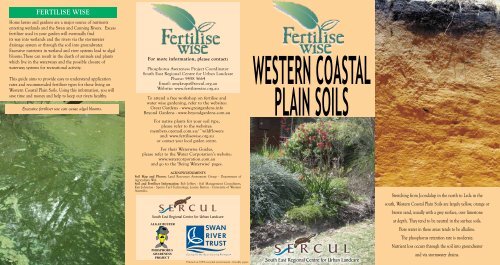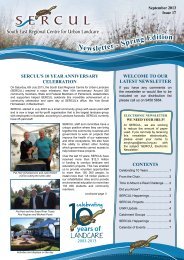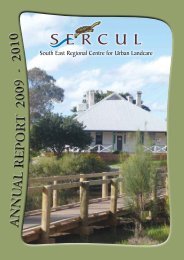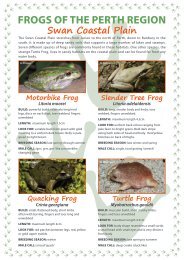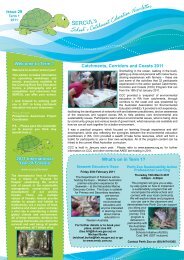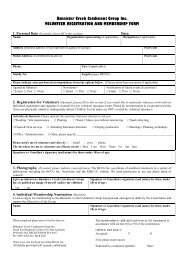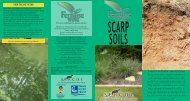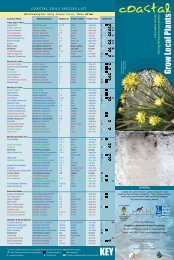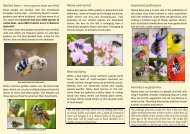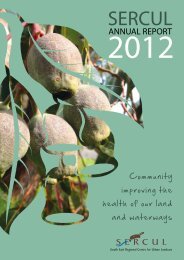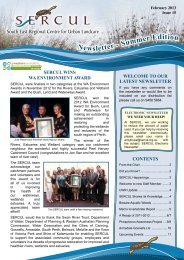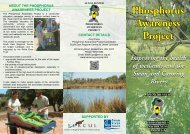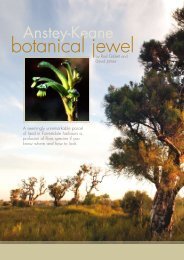Fertilise Wise Guide - SERCUL
Fertilise Wise Guide - SERCUL
Fertilise Wise Guide - SERCUL
- No tags were found...
Create successful ePaper yourself
Turn your PDF publications into a flip-book with our unique Google optimized e-Paper software.
<strong>Fertilise</strong> wiseHome lawns and gardens are a major source of nutrientsentering wetlands and the Swan and Canning Rivers. Excessfertiliser used in your garden will eventually findits way into wetlands and the rivers via the stormwaterdrainage system or through the soil into groundwater.Excessive nutrients in wetland and river systems lead to algalblooms.These can result in the death of animals and plantswhich live in the waterways and the possible closure ofwaterway systems for recreational activity.This guide aims to provide easy to understand applicationrates and recommended fertiliser types for those living onWestern Coastal Plain Soils. Using this information, you willsave time and money and help to keep our rivers healthy.Excessive fertiliser use can cause algal blooms.For more information, please contact:Phosphorus Awareness Project CoordinatorSouth East Regional Centre for Urban LandcarePhone: 9458 5664Email: amykrupa@sercul.org.auWebsite: www.fertilisewise.org.auTo attend a free workshop on fertilise andwater wise gardening, refer to the websites:Great Gardens - www.greatgardens.infoBeyond Gardens - www.beyondgardens.com.auFor native plants for your soil type,please refer to the websites:members.ozemail.com.au/~wildflowersand: www.fertilisewise.org.auor contact your local garden centre.For their Waterwise <strong>Guide</strong>s,please refer to the Water Corporation’s website:www.watercorporation.com.auand go to the 'Being Waterwise' pages.WESTERN coastalplain soilsAcknowledgmentsSoil Map and Photos: Land Resources Assessment Group - Department ofAgriculture WA.Soil and <strong>Fertilise</strong>r Information: Bob Jeffery - Soil Management Consultants,Ken Johnston - Sports Turf Technology, Louise Barton - University of WesternAustralia.ALGAE BUSTERPHOSPHORUSAWARENESSPROJECTPrinted on 100% recycled environment - friendly paper.Stretching from Joondalup in the north to Leda in thesouth, Western Coastal Plain Soils are largely yellow, orange orbrown sand, usually with a grey surface, over limestoneat depth. They tend to be neutral in the surface soils.Bore water in these areas tends to be alkaline.The phosphorus retention rate is moderate.Nutrient loss occurs through the soil into groundwaterand via stormwater drains.
Lawn is the most intensive part of any garden. It requires alarge investment of time, energy and resources to maintain alawn to a high level. Minimise lawn areas and replace themwith:• WA native groundcovers - Grevillea, Kennedia,Eremophila, Clematis, Hemiandra and Hardenbergia speciesare suitable alternatives offering stunning flower displays.• Paving – extend garden beds (possibly add a few localnative plants) and pave the rest of the area.• Gravel – extend garden beds (possibly add a few localnative plants) and put gravel over the rest of the area.When establishing a lawn consider what grass type issuitable for your conditions.Grass Type Buffalo Couch Kikuyu<strong>Fertilise</strong>rRequirementsWaterRequirementsIS A LAWN NECESSARY?ESTABLISHING A LAWNModerate High LowModerate Moderate ModerateShade Tolerance High Low ModerateTrafficability Low High HighTable1: Common grass species and their requirements.• High quality soil is essential for any successful garden,and lawn is no exception.• Add compost or soil improver to increase water andnutrient retention and to minimise non-wetting problems.Use at least two litres per square metre.• Plant buffalo rather than couch to reduce nutrientrequirements.• The best times to plant lawn from runners are duringearly autumn (March-April) or early spring (August-September) when conditions are mild to warm and there isless chance of losing fertiliser through heavy rains.• Roll-on turf is an easier and quicker way of establishing alawn. Roll-on also requires less fertiliser and can be plantedat any time of the year.• Apply small amounts of water frequently until deep rootsare established. For the first two weeks apply 4mm of waterthree times per day.FERTILISING REQUIREMENTS• Different grass species have different fertiliserrequirements to achieve a pale green lawn with an evengrowth rate.• <strong>Fertilise</strong>r should only be applied when symptoms ofnutrient deficiency occur (eg. yellowing).LOOK for the FERTILISE WISE endorsement for effectiveand responsible all purpose fertilisers.• Otherwise, when establishing a lawn use a completeestablishment lawn fertiliser with a Nitrogen to Phosphorusto Potassium (N:P:K) ratio of 10:2:6. Use a MAXIMUM of 25grams per square metre (g/m 2 ) (See Table 2).• For established lawns use a complete maintenance lawnfertiliser with a (N:P:K) ratio of 10:1:6. Use a MAXIMUM of25 grams per square metre (g/m 2 ) (See Table 2).• If the fertiliser you are using contains greater than 20%Nitrogen, then apply a MAXIMUM of 12 g/m 2 (See Table 2).• If fertiliser is required, apply two applications in springand two in early autumn (September, October, November,March and April) when grass grows rapidly.• DO NOT fertilise in summer or winter. Summerfertilising encourages over use of water. <strong>Fertilise</strong>r appliedduring winter will be washed into stormwater drains orleached into groundwater.Table 2: Nutrient analysis of fertilisers and their application rates. To check thenutrient analysis of a fertiliser, look for the percentages on the fertiliser bag.<strong>Fertilise</strong>rTypeCompleteEstablishmentCompleteMaintenanceMaintenancewith NitrogenNitrogen (N)Phosphorus (P)Potassium (K)A male hand can hold approximately 50 grams of fertiliser whilea female hand holds approximately 40 grams.• Soils affected by alkaline bore water may have traceelement deficencies. Ensure your fertiliser contains traceelements such as iron (Fe), manganese (Mn), boron (B) andzinc (Zn).• Other nutrients such as sulphur (S), magnesium (Mg),calcium (Ca) and the trace elements copper (Cu) andmolybdenum (Mo) may also be required for good growth.LAWN MAINTENANCEMaximumApplicationRate (g/m 2 )10 - 12% 1 - 2% 6 - 10% 2510 - 12% 0 - 1% 6 - 10% 25Greaterthan 20%Maximum <strong>Fertilise</strong>r Analysis0% 0% 12• Apply a soil amendment product (containing zeolite,bentonite clay, spongelite or fly ash), to the manufacturers’instructions, to improve the sand’s ability to hold onto waterand nutrients.• Apply a good quality wetting agent, to the manufacturers’instructions when fertilising, to improve lawn productivityand reduce run-off of water and nutrients.• To reduce thatch build up that promotes diseases andnon-wetting, use fertilisers sensibly and mow regularly with aclose-cut during autumn.• Areas of lawn with dead spots may respond to extrapotassium (in sulphate or potash) applied with a wettingagent from a watering can.• Extra potassium in autumn will toughen lawns for winter.<strong>Fertilise</strong> <strong>Wise</strong> - Effective and Responsible <strong>Fertilise</strong>r UseWatering <strong>Guide</strong>• Frequency of watering is based on your house number.• Two days a week have been allocated to water your garden.• To find out your sprinkler days, take the last digit of yourhouse number and apply it to the table below.• Water for a maximum of 15 minutes. Overwatering leadsto leaching of nutrients from the soil into groundwater.• During the wetter months, you will not need to wateryour garden.Last Digit ofHouse NUMBERYour TWOSPRINKLER DAYS1 Wednesday Saturday2 Thursday Sunday3 Friday Monday4 Saturday Tuesday5 Sunday Wednesday6 Monday Thursday7 Tuesday Friday8 Wednesday Saturday9 Thursday Sunday0 Friday Mondayenvironment-friendlygardening tips• Healthy soil is the key to a great garden. Use completefertilisers and amendments that improve soil, rather thanthose that provide a few water soluble nutrients.• Grow low fertiliser and low water use plants such as localnative plants.• Minimise the use of deciduous trees as falling leaves canenter stormwater drains and contribute to nutrient problemsin waterways.• Group plants with similar water/fertiliser/shaderequirements.• Plant deep rooted perennials rather than annuals.• Use a high quality, coarse mulch in garden beds toreduce watering (and thus minimise the amount ofnutrients seeping through soil and into groundwater).• Take care using raw animal manures that break downreadily leading to nutrient losses through the soil intoground water. Composted manures are better.


